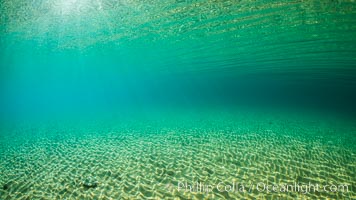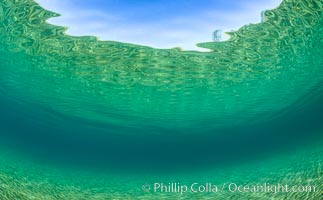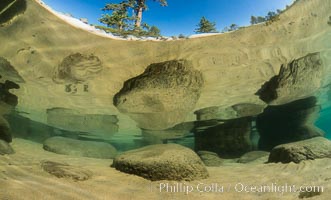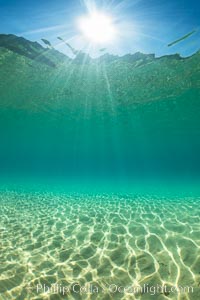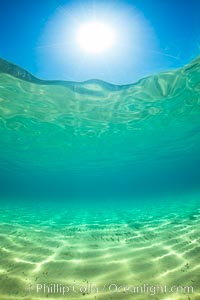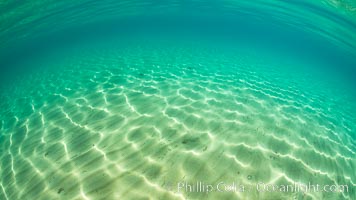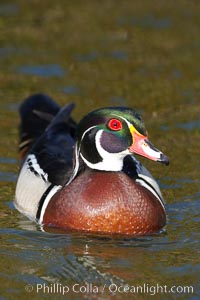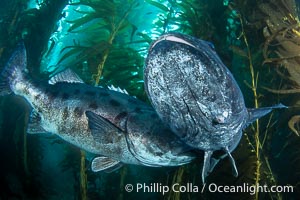
A male giant sea bass nudges a female giant sea bass to encourage spawning as they swim in a tight circle. This courting pair of giant sea bass is deep in the kelp forest at Catalina Island. In summer months, giant sea bass gather in kelp forests in California to form courtship and mating aggregations, eventually leading to spawning.
Species: Giant black sea bass, Stereolepis gigas
Location: Catalina Island, California
Image ID: 39435
Species: Giant black sea bass, Stereolepis gigas
Location: Catalina Island, California
Image ID: 39435
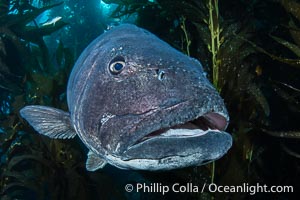
Closeup Portrait of the Face of a Giant Black Sea Bass, showing parasitic sea lice. These parasites find their nutrition from the skin and blood of the host giant sea bass. Smaller fishes such as senoritas and wrasses will commonly clean the sea lice off the giant sea bass.
Species: Giant black sea bass, Stereolepis gigas
Location: Catalina Island, California
Image ID: 39436
Species: Giant black sea bass, Stereolepis gigas
Location: Catalina Island, California
Image ID: 39436
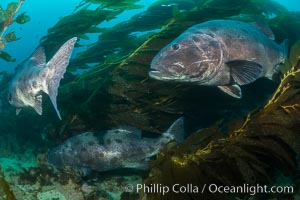
Three giant black sea bass, gathering in a mating/courtship aggregation amid kelp forest at Catalina Island. In summer months, black seabass gather in kelp forests in California to form mating aggregations. Courtship behaviors include circling of pairs of giant sea bass, production of booming sounds by presumed males, and nudging of females by males in what is though to be an effort to encourage spawning.
Species: Giant black sea bass, Stereolepis gigas
Location: Catalina Island, California
Image ID: 33355
Species: Giant black sea bass, Stereolepis gigas
Location: Catalina Island, California
Image ID: 33355
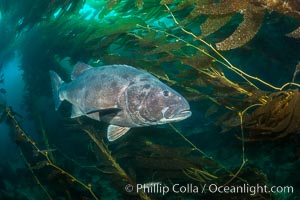
Giant Black Sea Bass with Unique Pattern of Black Spots at Catalina Island. The giant sea bass is an endangered species reaching up to 8' in length and 500 lbs, amid giant kelp forest.
Species: Giant black sea bass, Stereolepis gigas
Location: Catalina Island, California
Image ID: 33356
Species: Giant black sea bass, Stereolepis gigas
Location: Catalina Island, California
Image ID: 33356
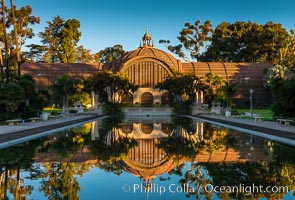
The Botanical Building in Balboa Park, San Diego. The Botanical Building, at 250 feet long by 75 feet wide and 60 feet tall, was the largest wood lath structure in the world when it was built in 1915 for the Panama-California Exposition. The Botanical Building, located on the Prado, west of the Museum of Art, contains about 2,100 permanent tropical plants along with changing seasonal flowers. The Lily Pond, just south of the Botanical Building, is an eloquent example of the use of reflecting pools to enhance architecture. The 193' by 43' foot pond and smaller companion pool were originally referred to as Las Lagunas de las Flores (The Lakes of the Flowers) and were designed as aquatic gardens. The pools contain exotic water lilies and lotus which bloom spring through fall.
Location: Balboa Park, San Diego, California
Image ID: 28823
Location: Balboa Park, San Diego, California
Image ID: 28823
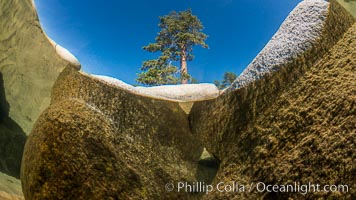
Split view of Trees and Underwater Boulders, Lake Tahoe, Nevada.
Location: Lake Tahoe, Nevada
Image ID: 32331
Location: Lake Tahoe, Nevada
Image ID: 32331
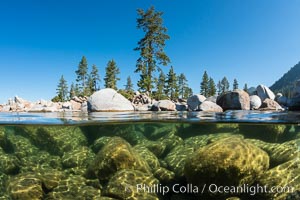
Split view of Trees and Underwater Boulders, Lake Tahoe, Nevada.
Location: Lake Tahoe, Nevada
Image ID: 32339
Location: Lake Tahoe, Nevada
Image ID: 32339
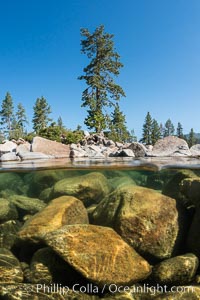
Split view of Trees and Underwater Boulders, Lake Tahoe, Nevada.
Location: Lake Tahoe, Nevada
Image ID: 32341
Location: Lake Tahoe, Nevada
Image ID: 32341
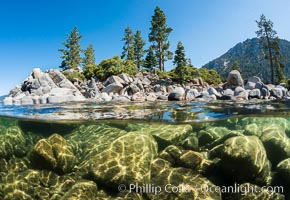
Split view of Trees and Underwater Boulders, Lake Tahoe, Nevada.
Location: Lake Tahoe, Nevada
Image ID: 32353
Location: Lake Tahoe, Nevada
Image ID: 32353
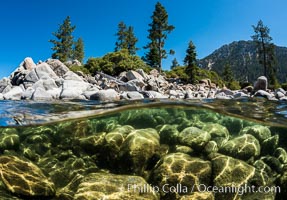
Split view of Trees and Underwater Boulders, Lake Tahoe, Nevada.
Location: Lake Tahoe, Nevada
Image ID: 32355
Location: Lake Tahoe, Nevada
Image ID: 32355
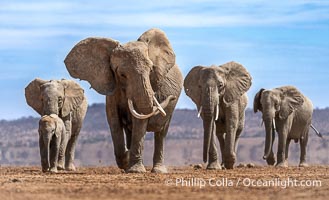
African elephant herd crossing dry lake bed, Amboseli National Park.
Species: African elephant, Loxodonta africana
Location: Amboseli National Park, Kenya
Image ID: 39560
Species: African elephant, Loxodonta africana
Location: Amboseli National Park, Kenya
Image ID: 39560
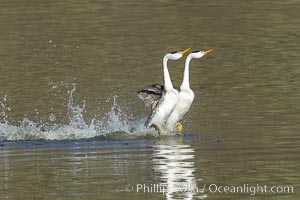
Clark's Grebes Rushing on Lake Hodges, San Diego.
Species: Clarks grebe, Aechmophorus clarkii
Location: Lake Hodges, San Diego, California
Image ID: 36830
Species: Clarks grebe, Aechmophorus clarkii
Location: Lake Hodges, San Diego, California
Image ID: 36830
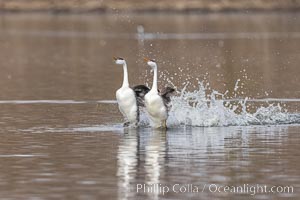
Western Grebes rushing in a courtship display. Rushiing grebes run across the water 60 feet (20m) or further with their feet hitting the water as rapidly as 20 times per second. Lake Hodges, San Diego.
Species: Western grebe, Aechmophorus occidentalis
Image ID: 36887
Species: Western grebe, Aechmophorus occidentalis
Image ID: 36887
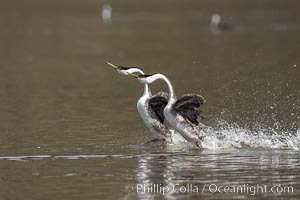
Western Grebes rushing in a courtship display. Rushiing grebes run across the water 60 feet (20m) or further with their feet hitting the water as rapidly as 20 times per second. Lake Hodges, San Diego.
Species: Western grebe, Aechmophorus occidentalis
Image ID: 36889
Species: Western grebe, Aechmophorus occidentalis
Image ID: 36889
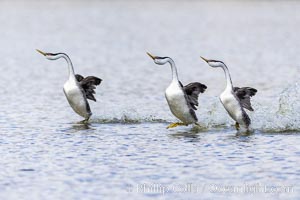
Western Grebes rushing in a courtship display. Rushiing grebes run across the water 60 feet (20m) or further with their feet hitting the water as rapidly as 20 times per second.
Species: Western grebe, Aechmophorus occidentalis
Location: Lake Hodges, San Diego, California
Image ID: 37854
Species: Western grebe, Aechmophorus occidentalis
Location: Lake Hodges, San Diego, California
Image ID: 37854
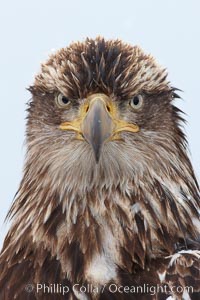
Juvenile bald eagle, second year coloration plumage, closeup of head and shoulders, looking directly at camera, snowflakes visible on feathers. Immature coloration showing white speckling on feathers.
Species: Bald eagle, Haliaeetus leucocephalus, Haliaeetus leucocephalus washingtoniensis
Location: Kachemak Bay, Homer, Alaska
Image ID: 22589
Species: Bald eagle, Haliaeetus leucocephalus, Haliaeetus leucocephalus washingtoniensis
Location: Kachemak Bay, Homer, Alaska
Image ID: 22589
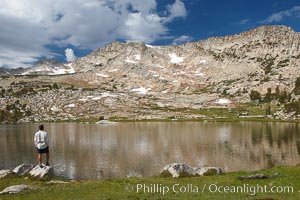
Hiker views Vogelsang Lake, and Vogelsang Peak (11516') at sunrise in Yosemite's High Sierra.
Location: Yosemite National Park, California
Image ID: 23201
Location: Yosemite National Park, California
Image ID: 23201
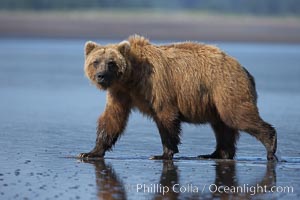
Brown bear walks on tide flats. Grizzly bear.
Species: Brown bear, Ursus arctos
Location: Lake Clark National Park, Alaska
Image ID: 19136
Species: Brown bear, Ursus arctos
Location: Lake Clark National Park, Alaska
Image ID: 19136
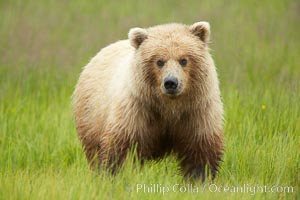
Juvenile female coastal brown bear (grizzly bear) grazes on sedge grass.
Species: Brown bear, Ursus arctos
Location: Lake Clark National Park, Alaska
Image ID: 19137
Species: Brown bear, Ursus arctos
Location: Lake Clark National Park, Alaska
Image ID: 19137
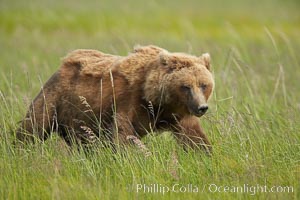
Coastal brown bear in meadow. The tall sedge grasses in this coastal meadow are a food source for brown bears, who may eat 30 lbs of it each day during summer while waiting for their preferred food, salmon, to arrive in the nearby rivers.
Species: Brown bear, Ursus arctos
Location: Lake Clark National Park, Alaska
Image ID: 19138
Species: Brown bear, Ursus arctos
Location: Lake Clark National Park, Alaska
Image ID: 19138
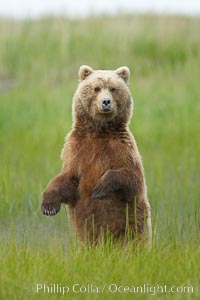
A brown bear mother (sow) stands in tall sedge grass to look for other approaching bears that may be a threat to her cubs.
Species: Brown bear, Ursus arctos
Location: Lake Clark National Park, Alaska
Image ID: 19139
Species: Brown bear, Ursus arctos
Location: Lake Clark National Park, Alaska
Image ID: 19139
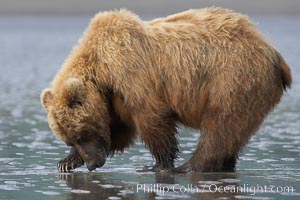
Coastal brown bear forages for razor clams in sand flats at extreme low tide. Grizzly bear.
Species: Brown bear, Ursus arctos
Location: Lake Clark National Park, Alaska
Image ID: 19140
Species: Brown bear, Ursus arctos
Location: Lake Clark National Park, Alaska
Image ID: 19140
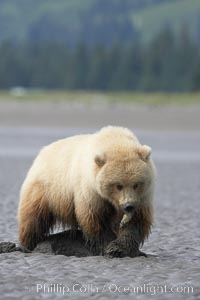
Juvenile female brown bear forages for razor clams in sand flats at extreme low tide. Grizzly bear.
Species: Brown bear, Ursus arctos
Location: Lake Clark National Park, Alaska
Image ID: 19141
Species: Brown bear, Ursus arctos
Location: Lake Clark National Park, Alaska
Image ID: 19141
